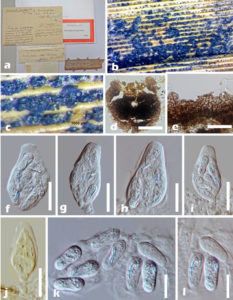Wallrothiella bromeliae Rehm, Hedwigia 40: 103 (1901)
Index Fungorum number: IF 182944; Facesoffungi number: FoF 02968
Saprobic on wood. Sexual morph: Stromata 200–275 × 300–425 μm, superficial, aggregated into groups, fragile, hemispherical, glabrous, black, mixed with white fungal hyphae, scattered over the surface, forming black areas, sessile, subcarbonaceous, with white or pale ostiole visible on the surface of the ascomata, with a short neck. Ascomata 150–200 μm diam., globose, brown, sometimes with a short neck. Peridium < 50 μm, composed of several layers of brown-black, elongated cells. Paraphyses 3–5 μm wide near the asci, hyaline, numerous, filiform, tapered, embedded in a gelatinous matrix. Asci 25–40 × 15–20 μm, 8-spored, unitunicate, pyriform–clavate, apedicellate or rarely short-pedicellate, sessile, wide at middle, narrowed towards the apex, thick–walled at the apex, without apical ring. Ascospores 10–15 × 4–6 μm, overlapping uniseriate, unicellular, ellipsoidal─ovate, in face view constricted at the middle, hyaline, guttulate.
Material examined – BRAZIL, Rio de Janeiro, Maua, on Bromelia fastuosa Lindl. (Bromeliaceae), 1896-04, Ule (S─F5832).
Notes – Wallrothiella bromeliae differs from the type W. congregata in having pyriform asci with thick–walled and ovate ascospores. However the ascomata of both species are similar in having superficial, short-beaked ascomata occurring in large clusters (Réblová & Seifert 2004).
Fig. Wallrothiella bromeliae (F5832). a Herbarium details. b, c Ascomata in wood. d Cross section of ascomata. e Peridium. f–i Mature asci. j Asci in Melzer’s reagent. k–l Ascospores. Scale bars: b = 200 μm, c = 1000 μm, d = 100 μm, e = 20 μm, f–j = 20 μm, k, l = 10 μm.

